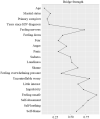Unraveling the central and bridge psychological symptoms of people living with HIV: A network analysis
- PMID: 36684950
- PMCID: PMC9846149
- DOI: 10.3389/fpubh.2022.1024436
Unraveling the central and bridge psychological symptoms of people living with HIV: A network analysis
Abstract
Background: People living with HIV (PLWH) experience multiple psychological symptoms. Few studies have provided information on central and bridge psychological symptoms among PLWH. This information has implications for improving the efficiency and efficacy of psychological interventions. Our study aimed to identify the central and bridge psychological symptoms of PLWH and to explore the interconnectedness among symptoms and clusters.
Methods: Our study used data from the HIV-related Symptoms Monitoring Survey, a multisite, cross-sectional study conducted during 2017-2021. We used R to visualize the network of 16 symptoms and analyzed the centrality and predictability indices of the network. We further analyzed the bridge symptoms among the three symptom clusters.
Results: A total of 3,985 participants were included in the analysis. The results suggested that sadness had the highest strength (r S = 9.69) and predictability (70.7%) compared to other symptoms. Based on the values of bridge strength, feeling unsafe (r bs = 0.94), uncontrollable worry (r bs = 0.82), and self-abasement (r bs = 0.81) were identified as bridge symptoms. We also found a strong correlation between sadness and self-abasement (r = 0.753) and self-loathing and self-blame (r = 0.744).
Conclusion: We found that sadness was the central psychological symptom of PLWH, indicating that sadness was the center of the psychological symptom network from a mechanistic perspective and could be a target for intervention. Deactivating bridge symptoms, including "feeling unsafe," "self-abasement," and "uncontrollable worry," could be more effective in preventing symptom activation from spreading (e.g., one symptom activating another).
Keywords: HIV/AIDS; PLWH; network structure; psychological network; symptom management.
Copyright © 2023 Wen, Zhu, Hu, Li, Jiang, Li, Zhang, Fu, Han, Wu and Hu.
Conflict of interest statement
The authors declare that the research was conducted in the absence of any commercial or financial relationships that could be construed as a potential conflict of interest.
Figures




Comment on
-
A cross-sectional, population-based study measuring comorbidity among people living with HIV in Ontario.BMC Public Health. 2014 Feb 13;14:161. doi: 10.1186/1471-2458-14-161. BMC Public Health. 2014. PMID: 24524286 Free PMC article.
References
-
- UNAIDS . In Danger: UNAIDS Global AIDS Update 2022. Geneva: UNAIDS; (2022).
-
- Moseholm E, Aho I, Mellgren Å, Pedersen G, Katzenstein TL, Johansen IS, et al. . Psychosocial health in pregnancy and postpartum among women living with- and without HIV and non-pregnant women living with HIV living in the Nordic countries: results from a longitudinal survey study. BMC Pregnancy Childbirth. (2022) 22:20. 10.1186/s12884-021-04357-5 - DOI - PMC - PubMed
Publication types
MeSH terms
LinkOut - more resources
Full Text Sources
Medical
Research Materials

